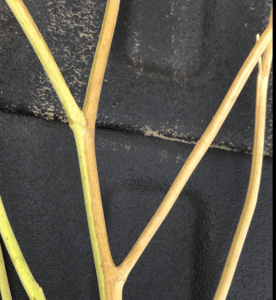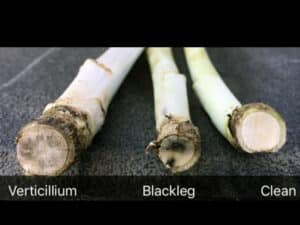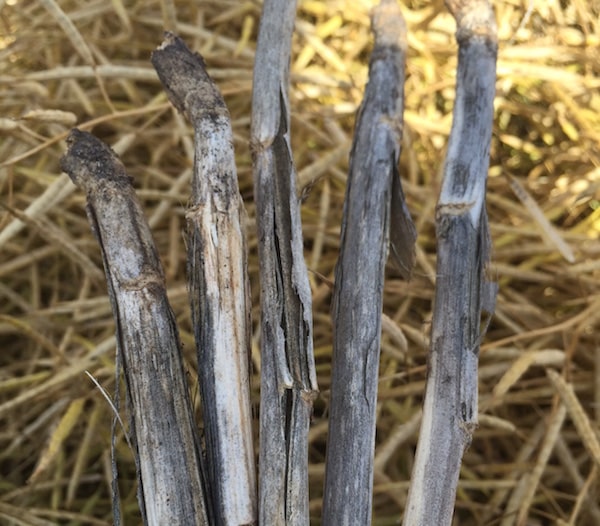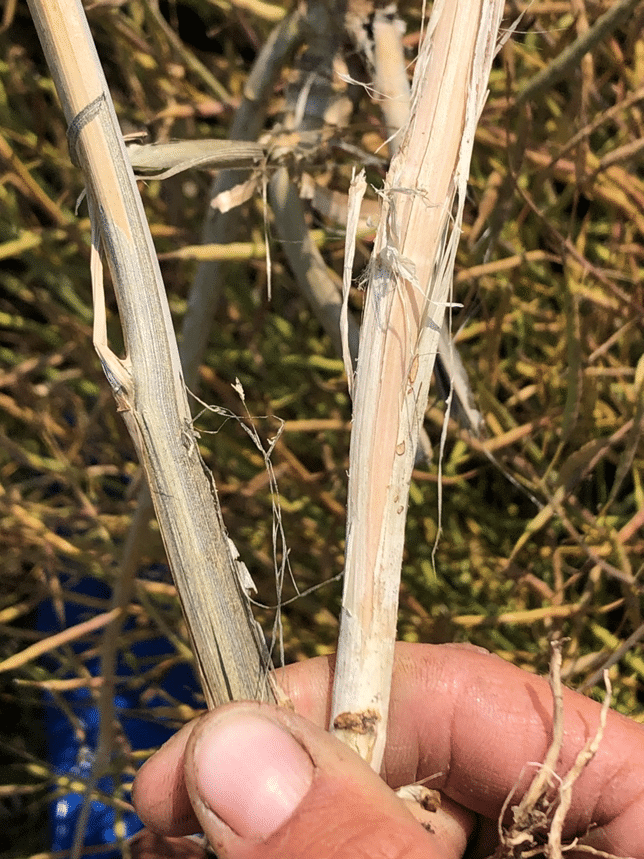August 6, 2025 – First detected in canola in Manitoba in 2014, verticillium stripe is now found across the Prairies. According to 2024 disease surveys from the three Prairie provinces, this soil-borne pathogen was confirmed in 60 per cent of fields surveyed in Manitoba, 32 per cent of fields surveyed in Saskatchewan and six per cent of fields surveyed in Alberta.
In a 2024 Canola Council of Canada survey of 500 growers, verticillium stripe is also rising in the list of diseases, insects and weeds that pose the greatest economic risk to their canola production. Flea beetles, sclerotinia stem rot and herbicide-resistant weeds were the most common responses throughout 2024, 2022 and 2020. Only two per cent of growers put verticillium stripe as their “greatest economic risk” in 2020. That rose to six per cent in 2022 and 14 per cent in 2024. The Manitoba number last year was 36 per cent, putting it third in the latest survey (behind flea beetles and sclerotinia stem rot).
Distinguishing verticillium stripe from other canola diseases like blackleg or sclerotinia stem rot can take some practice. The ideal time to scout is at harvest when symptoms are most obvious. This article provides tips on accurately identifying verticillium stripe.
Symptom one: stem striping.

When the crop is beginning to mature but is still green, canola plants infected with verticillium stripe will often have a two-toned stem – half healthy and green and half discoloured and drying down. This is where the “stripe” name comes from. Leaves can show similar symptoms – healthy on one side, diseased on the other. You will not see stem or leaf striping with blackleg or sclerotinia stem rot. Sclerotinia will cause stem discolouration, but it will not stripe half the stem.
Symptom two: stem cross section discolouration.
Verticillium stripe infects roots and enters the plant’s vascular system. Verticillium hyphae and conidia fill up the vascular system, giving the stem cross section a greyish colour. This is easily confused with blackleg. We have two tips to distinguish the pathogens:
- With blackleg, stem tissue infection tends to be darker and cause distinct wedge shapes of black. Verticillium is lighter grey and more general throughout the cross section.
- Blackleg stem discolouration is confined to the crown area at the base of the stem. Verticillium darkening can extend well up the stem.
Symptom three: black specks.
As verticillium infection advances, microsclerotia will start to form on the underside of peeling stem skin and in the spongy centre of the stem. These can be found all the way up the stem. Verticillium specks may seem similar to blackleg pycnidia, but they’re much smaller – more like powdery pepper. In some cases, blackleg pycnidia will have a purple-pinkish ooze of pycnidiospores around them. Blackleg pycnidia are also confined to a lesion no more than a couple centimetres in size. If you see pink and specks confined to a lesion, it’s blackleg.
Symptom four: stem peeling and weakening.
Peeling stem skin is a symptom of verticillium stripe. Under that peeled outer layer will be the microsclerotia, often taking the shape of faint black vertical striping. Severely diseased stems may break off and can be confused with lodging. Sclerotinia stem rot will also cause weakened brittle stems, but sclerotinia will not have the stripy, speckly microsclerotia. Sclerotinia stem rot will cause the entire stem tissue to shred, not just the outer layer. Inside the stem, sclerotinia will form sclerotia bodies – the canola-seed-sized resting bodies. Verticillium stripe does not produce sclerotia bodies.
Management options for verticillium stripe are limited, but accurate identification is the first step to proper management. Some cultivars claim improved tolerance, but we don’t have genetic resistance. Verticillium microsclerotia are soil-borne, so steps to keep soil in place could provide some reduction in spread. Two- or three-year breaks between canola crops are good disease management in general, but verticillium microsclerotia can remain viable for many years.
Blackleg and sclerotinia stem rot, if those are the diseases present, are more manageable through genetic resistance, crop rotation and fungicides.
For more on verticillium stripe identification and management, read the verticillium stripe chapter in the Canola Encyclopedia and the Canola Watch Fundamentals article: “How to identify verticillium stripe”.


